

 The South African
The South African
Introduction
It was 1915. The German Army was on the retreat in South West Africa. The Union forces under overall command of the South African Prime Minister, General Louis Botha, had been advancing on four fronts: the Northern, from Swakopmund onwards to Windhoek; the Central, Lüderitzbucht onwards to Aus and then east; the Southern, from Upington onwards to Keetmanshoop; and the Eastern, from Kuruman onwards to Keetmanshoop. The major action that involved the Kimberley and Rhodesian troops was that of Trekkopjes, a railway siding on the northern route from Swakopmund to Windhoek. Both were units of the 3rd Infantry Brigade, but among the units raised in Kimberley, it was to be the 2nd Battalion, The Kimberley Regiment, under command of Lt-Col T Rodger, that was to bear the brunt of the war in German South West Africa.
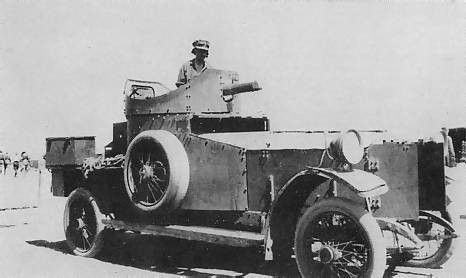
Armoured Car
In November of 1914, after only a few weeks’ training, ‘B’ Company, 2nd Kimberley Regiment was sent by train to protect Mafeking in case of an attack by the Rebels. They spent several what must have been boring weeks guarding Mafeking, Ramoutsa and Gaberones (Botswana) before returning to Kimberley in December. With the rebellion brought under control by the government forces, the battalion was then sent off by train to Cape Town where they then travelled by ship to Walfisch Bay, arriving there on Christmas Day 1914 (MS 56, Lt-Col T Rodger diary KAL), as did the 1st Battalion Imperial Light Horse (Klein, Harry. Light Horse Cavalcade 1899-1961).
The 1st Rhodesia Regiment arrived on Boxing Day and disembarked from the SS Monarch. By the end of October 1914, the 1st Rhodesia Regiment had been formed with 530 officers and men. (South Africa, March 1915).
Both regiments would be part of the Northern route with the 3rd Infantry Brigade under overall command of Colonel Burnside, who was replaced by Colonel P C B Skinner on 11 February 1915, the former reverting to command the 1st Battalion Rhodesian Regiment. (MS 56 Lt-Col T Rodger diary KAL). Burnside’s second-in-command was Major Methuen from Umtali, promoted to the post that same month. (Methuen is one of the two brothers who raised the Cross on Umtali’s famous Cross Kopje in memory of the black soldiers who died in the First World War) (South Africa, 13 February 1915). For the sake of clarity, the 3rd Brigade consisted of 2nd Transvaal Scottish, 2nd Kimberley Regiment, and the 1st Rhodesia Regiment. The 4th Brigade, in the same area, consisted of the 1st Durban Light Infantry, the SA Irish Regiment and the Rand Rifles, all under command of Colonel JS Wylie.
Colonel Skinner advanced with a strong reconnaissance force consisting of mostly the Imperial Light Horse on 13 January 1915, and on 16 January formally annexed Swakopmund to the Union of South Africa. Colonel Burnside, as Garrison Commander at Swakopmund, took the salute as the Union Jack was raised outside the Mayor’s offices. On parade were a troop of ILH, and half a company of both the 1st Rhodesia Regiment and the 2nd Transvaal Scottish (Klein, Harry).
Fortified and entrenched positions were erected and dug at Swakopmund – remnants of the 2nd Kimberley Regiment and 2nd Durban Light Infantry regimental badges made of quartz stones can still be seen.
The Rhodesia Regiment was there too
While the Rhodesians were constructing these entrenchments several suspicious looking metal drums, full of a liquid into the nature of which none was sufficiently curious to enquire (the poisoning of the wells by the enemy having produced a dampening effect upon the ardour of the more inquisitive ones) were pressed into service as supports to the loose sandy sides of the excavations. Men record today in sorrowful tones how they unconsciously slept against those casks for nights on end, and it fell to the lot of a private of a relieving regiment, guided presumably by instinct, to thrust his bayonet unerringly into the heart of the nearest barrel, producing a fountain of - German beer! (Rayner & O’Shaugnessy).
Private Tyrell of the Rhodesia Regiment never mentioned the beer: ‘We were hurried up here by sea from Walfisch Bay about ten days ago, at half an hour’s notice, and to my surprise the landing was uncontested. We had plenty of work to do for a day or two after we landed; digging trenches, etc all around town, and when we had done this job in a most luxurious manner and had made ourselves really comfortable, we were ordered to move out a few miles to take up an outpost among the sand dunes. Old Burnside ... seems most anxious that the Rhodesians shall make a name for themselves, and consequently we were first on outpost duty at Walfisch Bay, first to land Swakopmund, and now first to advance inland. We only have a very small force of Germans in front of us here, but they kept our chaps continually on the move, as they know the country so well. I see their scouts every night and almost every morning. I must say these German chaps here are behaving in a very sportsmanlike manner, and the only reason I can ascribe for this is that they are in a blue funk and know their days in this country are numbered ...’ (South Africa, 20 March 1915).
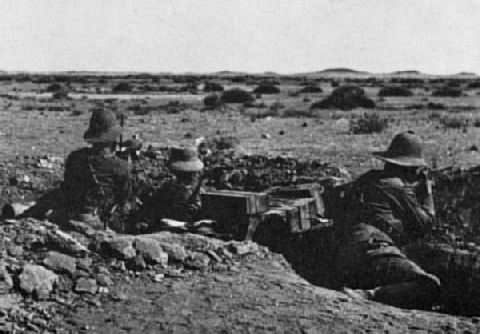
Waiting for the enemy to attack
Underestimating the enemy is one of the problems of most wars, and the campaign in SWA was no exception. The 1st Rhodesia Regiment had outposts on sandy dunes beyond the camp at Swakopmund and would return each night and then the following morning take up their positions again. The sand-dunes here run inland in long series from north to south for a few miles only when the ground becomes firm and pebbly with a gentle undulation towards Nonidas. The Rhodesians held the last ridge but one of the sand-dunes, daily sending forward a few men as outposts in the early morning to overlook the open country and returning them back at nightfall nearer to the main picket. Such was the position on Sunday, February 7. Colonel Skinner moved out before dawn with the ILH and a detachment of his only available artillery (the Heavy Artillery Brigade) to reconnoitre the enemy's position beyond the Rhodesian outposts ... the enemy had also dispatched a reconnoitring party, who, during the night, occupied the last sand-dunes already referred to and, at daybreak, as the Rhodesians were crossing the open space dividing the ridges, opened fire upon the surprised men, killing two outright (Rayner & O’Shaugnessy).
The two Rhodesians ‘were shot at short range with pointed bullets, which make very ugly wounds’ (MS 56 Lt-Col T Rodger diary KAL). They were No 158 Private Charles Clayton and No 189 Private Ben Rabinson.
The Plan
The plan was that Skinner’s 3rd Brigade was to advance inland towards Windhoek along the railway line, repairing and constructing as they went along, and leaving manned blockhouses to guard the line. The Germans had laid many mines and dynamite booby traps, most of which were dismantled by the SAEngineering Corps.
Bombing
On 9 April, the Germans bombed the Brigade by aeroplane, two bombs exploding harmlessly near the Transvaal Scottish camp. By the next day, the Kimberley Regiment had a makeshift anti-aircraft gun in position – a Maxim machine gun mounted on a cart – ‘... fixed up to deal with aeroplane’ (MS 56 Lt-Col T Rodger diary KAL).
The Kimberley Regiment left the main camp together with the 2nd ILH on 10 February, heading alongside the railway in the direction of Arandis. There were many hold-ups to explode booby traps left by the Germans, but, with some good rain falling, the temperatures were fine to march along at a brisk pace and Arandis was reached on the 12th.
The German aeroplane visited Arandis on 15 February, but despite some aggressive anti- aircraft fire from the Kimberley Regiment, the German plane still dropped its two bombs and made off – no casualties being reported from either side.
Trekkopjes
Instructions to march to Trekkopjes – some 75 miles (about 120 km) from Swakopmund – was given on 23 April. At 06.00 the column moved off, the Regiment reaching their destination at 10.15 after a breakfast stop. At the time, the battalions of the 3rd Brigade were quite spread out: the 1st ILH and 1st Rhodesia Regiment at Arandis, 20 miles (32 km) west of Swakopmund on the Trekkopjes side, the Brigade artillery at Swakopmund, while Skinner had moved to Trekkopjes with three squadrons of the ILH, the 2nd Kimberley Regiment and the 2nd Transvaal Scottish.
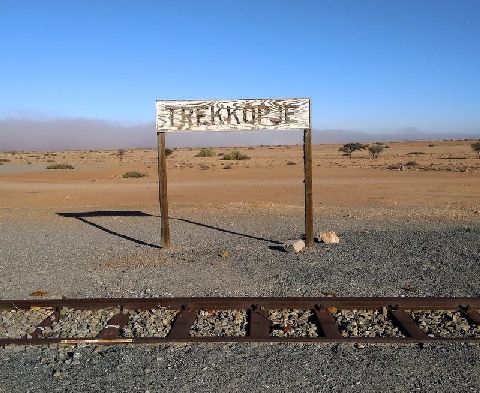
Siding name - not even a platform
On the night of 25/26 April, Colonel Skinner was on a reconnaissance patrol with the Imperial Light Horse (and some Transvaal Scottish) to Ebony, some 18 miles (29 km) eastwards of Trekkopjes, having left Colonel T Rodger of Kimberley in command at the base camp at Trekkopjes. At 01.00 on the 26th, a German force was observed marching towards the camp. The heavy dust storm did not allow Rodger to ascertain numbers, but the dust did allow Skinner to return post-haste to camp without being noticed. At 03.30 Rodger telephoned GHQ at Swakopmund explaining the situation and requested artillery support. A train with two 4-inch guns plus two squadrons Southern Mounted Rifles was sent immediately, while, at about the same time, Skinner called in to the Trekkopjes camp the 1st Rhodesia Regiment from Arandis, who had been guarding the railway line to his rear (Curson, H H, History of the Kimberley Regiment).
At 05.45 the Germans destroyed the line to the north of Trekkopjes, a pointless exercise, as it did not deflect any Union reinforcement from coming from the south towards Trekkopjes.
Two batteries of German guns approached from the north, and from 5 000 yards (4 070 m) shelled the camp, coupled to an infantry advance at 07.40. The shelling lasted the entire battle, but despite this, the infantry fire from the shallow trenches, as well as fire from nine armoured cars, put paid to all assaults by the Germans, who at best, managed to get within 50 yards (41 m) of the Union forces. The Rhodesia Regiment had arrived shortly before the German attack and had entrenched to the left of the 2nd Kimberley Regiment.
There were four assaults by the Germans. The first was against the Rhodesians who had just detrained; the second was against the Kimberley Regiment, the third against the right side of the Kimberley Regiment and the left side of the Transvaal Scottish, while the fourth was against the Transvaal Scottish.
According to Captain D R Hunt, 2nd Transvaal Scottish: ‘The 2nd Kimberleys suffered most on our side. They had a trench next to our left, with a high, built up wall which made a good artillery mark for the Germans and we could see they were getting it hot, but they stuck well to their position.’ (Juta, HC. History of the Transvaal Scottish.
The Germans withdrew from the field of battle at 10.30, coming under fire from the Brigade anti-aircraft guns (South Africa, 1 May 1915).
Analysis: Strength and casualties
Sources vary in their details regarding the number of men who took part in the battle. The Germans had between 800 and 1 500 men and the South Africans and Rhodesians numbered about 1 500 men.
With regards to casualties, at least eleven South African and Rhodesian soldiers were killed or died of wounds, and between 29 and 32 were wounded. The Germans lost between nine and fourteen killed, with fourteen wounded and about thirteen taken prisoner.
Killed in Action or Died of Wounds
Kimberley Regiment
| Anderson, WE | Private |
| Cameron, TA | Lance Corporal |
| Filler, DA | Lance Corporal |
| Good, AH | Private (Died of Wounds same day) |
| Harrison, F | Captain |
| Lambie, Alec | Private |
| Manning, FE | Private (Died of Wounds 10 May 1915) |
| Wells, JR | Lance Corporal |
1st Battalion Rhodesia Regiment
| Hollingsworth, F | Lieutenant |
Transvaal Scottish
| Cameron, WM | Lieutenant |
| Lambie, Alec | Private |
| Campbell, A | Private |
| Chrystal, AC | Lance Corporal |
| Cross, RG | Private |
| Henderson, J | Lance Corporal |
| Wood, LF | Corporal |
Lieutenant Frederick Hollingsworth, aged 31 years, had come from the Rand to Umtali in 1912 as the Works Manager in the Railway Locomotive Shop. Formerly with the Witwatersrand Rifles, he soon received a commission and when the 1st Rhodesia Regiment left for German South West Africa, he was officer in charge of the Maxim detachment.
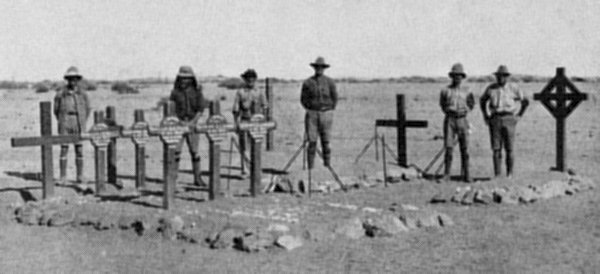
Casualties were buried in this small cemetery
Photograph from back cover:
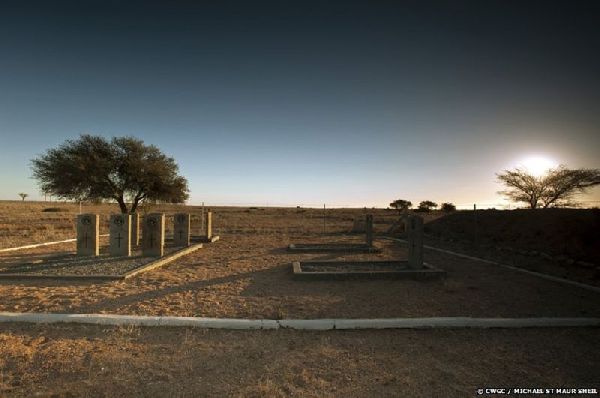
Long shadows lie across the Trekkopjes cemetery,
now cared for by the Commonwealth War Graves Commission
Sporting Connections
In early 1915 at Walfisch Bay, an Inter-Regimental rugby competition was played, being won by the Rhodesia Regiment who never lost a game playing against teams such as the Imperial Light Horse, Rand Rifles, and South African Irish, who all fielded several Springboks. In the Rhodesian Regiment rugby team, among others, were Ben Rabinson, Tommy Thomas, D du Toit, Tom Bourdillon, Curly Wright, G Blackbeard, Erikson, GAP Thomas, C Ferris, D Philip, JJ Phillips, Reg Hart, and Major Methuen. (Thompson, J De L, The Story of Rhodesian Sport).
Ben Rabinson was one of three Jewish brothers – Ben, Phil and ‘L’ – who had played rugby for Rhodesia in the 1914 Currie Cup tourney at Durban and, in 1912, Ben and Phil had impressed as three-quarters when playing against SACS (UCT). They were invited to the Springbok trials in Cape Town, but despite scoring in all three of the trial games, they were not chosen.
The Rabinsons were outstanding among the three quarters and their omission from the Springbok team was a mystery to all who saw them (Thompson, J DeL. The Story of Rhodesian Sport).
Ben had also played for Rhodesia against the touring British Lions in 1910, a game lost by Rhodesia 24-11. He was also an above average cricketer, who, although never playing for Rhodesia, was the Captain of King’s Club in Bulawayo who won the 1st league from 1910 until 1914, and again after the war. Playing for Matabeleland against Transvaal in 1913, Ben top-scored with 54 runs in the first innings. In the Logan Cup final in 1911-12 when Matabeleland beat Mashonaland, Rabinson again scored 81 runs in their innings of 429 runs. In the Mashonaland second innings of 133 – which ensured an innings victory for the Matabele side – Rabinson took 3 wickets for 26 runs.
Comment from a relative now living in Australia
You mention the death of Private Ben Rabinson of the 1st Rhodesian Regiment. He was my great-uncle. On the last page, the author wrote “Ben Rabinson was one of three Jewish brothers – Ben, Phil and ‘L’ – who had played rugby for Rhodesia in the 1914 Currie Cup tourney at Durban and, in 1912, Ben and Phil had impressed as three-quarters when playing against SACS (UCT). They were invited to the Springbok trials in Cape Town, but despite scoring in all three of the trial games, they were not chosen.”
The brother referred to as “L”, was Lionel Rabinson, my grandfather. I’m sure this fact is of little consequence to what I found to be a most interesting article. One other, and related matter, while clearing out my mother’s effects in PE some 15 years ago, I came across a letter written from the Regimental Chaplain to Lionel, my grandfather. The Chaplain had been in the field when Ben was killed and described briefly what had happened, including the fact that Ben had fired his rifle. I found this observation interesting, perhaps that at least he had engaged the enemy.
Chris Nunns PhD MAPS
Return to Journal Index OR Society's Home page
South African Military History Society / scribe@samilitaryhistory.org